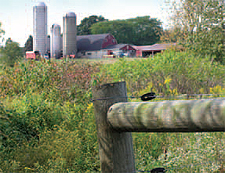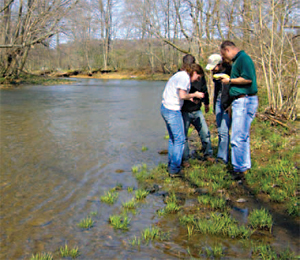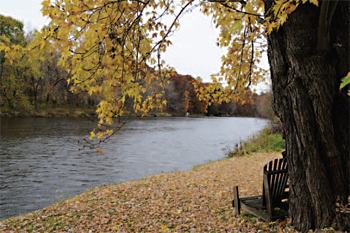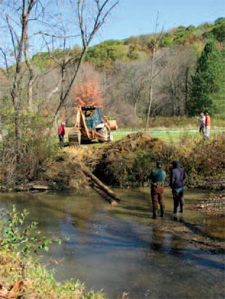The Watershed Conservation Program Celebrates its Tenth Anniversary
Ten years ago, the Western Pennsylvania Conservancy started a program to provide technical assistance to watershed groups around the region. Nick Pinizzotto was the lone employee of what was then known as the Watershed Assistance Center.

The Watershed Conservation Program works with farms like this to protect their watersheds.
This “one-stop shop” was designed to help groups with a variety of water conservation needs — from learning how to prepare grant proposals to accessing technical resources and planning tools.
Pinizzotto finished that first year realizing just how important such a center was for Western Pennsylvania. With its mission and scope of work rapidly expanding, the program and its six full-time employees soon moved to a new office in Blairsville that could accommodate the increasing demands.
The program’s growth continued through what Pinizzotto describes as, “calculated risk-taking that made good business and conservation sense.” Today, the Watershed Conservation Program is a comprehensive resource for practically anything related to protecting rivers and streams. Program staff is adept at identifying watershed problems, designing solutions, securing proper permitting with local governments to do the work and ensuring that conservation measures are in place.
“There is almost nothing in terms of water quality that we don’t get involved with or can’t do,” said Pinizzotto, who indicated a strong foundation was laid in the early years of the program.
“We recognized where there were needs and we found creative ways to meet them,” said Pinizzotto, now associate vice president of WPC’s Watershed Conservation Program. “We weren’t afraid to take on new things or to take risks. It is a testament to the Conservancy that its leadership let this program grow. I never felt handcuffed or held back.”

Acquatic scientists conducting a survey at Little Mahoning Creek
Pinizzotto and his team recognized early on, for instance, that agriculture has one of the most significant impacts on the region’s waterways. Crops planted in floodplains and cows grazing near streams cause fertilizer and manure to overload water with nutrients.
However, many farmers lack the financial and planning resources to implement best management practices. Within the program’s first three years, Pinizzotto’s group created a comprehensive agriculture assistance program to help with the design and installation of features like cattle fences and barn gutters. To date, more than 500 farmers have participated in the program.
While the Watershed Conservation Program continues to focus on its original objectives, it has expanded its services and staff of biologists, natural resource managers, geographers and others, to meet the needs of this program.
The program staff now occupies an expanded office near the Indiana University of Pennsylvania’s campus in Indiana, Pa. The office includes a library, a conference room with state-of-the-art technology, new cubicles and a large fish tank with Pennsylvania native trout.
A small laboratory at the new site houses field specimens and upgraded scientific equipment, including two top-of-the-line microscopes that help scientists identify even the smallest macro-invertebrates. Other equipment enables them to classify aquatic life, conduct water quality and chemistry tests and conduct visual assessments.
Despite significant growth, the program has not lost sight of its original goal to provide grassroots assistance to watershed organizations.

French Creek, Crawford County.
“Our initial interaction with the Conservancy’s watershed program was over five years ago when they helped us obtain a Growing Greener grant from the state,” said Jim Powell, chairman of the Buffalo Creek Watershed Association. “We developed one of the first watershed protection plans. Most plans were about remediation. Our plan was designed to protect the stream, because Buffalo Creek is a pristine waterway.”
Since then, WPC has worked with the Buffalo Creek Watershed Association on other initiatives including outreach. Last fall, WPC staff showed more than 30 Boy Scouts on Dutch Fork Creek how to catch and monitor fish. Last August, the two groups collaborated on a streambank improvement project.
“I speak for all of the watershed association members; it has been a wonderful experience working with Nick and his staff. They have been most helpful,” Powell said. Mike Pardee of the Little Mahoning Creek Watershed Association had similar praise.
“We’ve done quite a few projects with the Conservancy that made a tremendous impact on Little Mahoning Creek,” he said, referring to grant-writing, a dam removal, and a litter pickup that yielded 33 tons of trash. “We now see fish in the creek and mussels along the stream banks.”

Watershed staff installs a multilog vane deflector in Tubmill Creek, used for erosion control and creation of fish habitat.
An article in the May 2001 issue of Conserve outlined the center’s original four objectives. They were:
- 1. Provide technical assistance to
watershed groups and like-minded
organizations. Since then, the
Watershed Conservation Program
has provided technical assistance to
nearly 550 different entities; most of
them are in Western Pennsylvania,
but some are as far away as Hawaii.
- 2. Abate point and non-point source
pollution. Today, the program works
to address all types of pollution from
erosion and sedimentation to abandoned
mine drainage. This is accomplished
through direct implementation of best
management practices, most of which
are designed and built by WPC staff.
- 3. Protect high-quality watersheds.
The Watershed Conservation Program
has helped protect and restore dozens
of high-quality watersheds. This includes
removing unnecessary
dams, building new stream buffers
and helping to develop numerous
watershed management plans for
implementation by program partners.
The program has specific initiatives to
protect and restore several biologically
diverse waterways, such as Little
Mahoning Creek, which hosts a variety
of freshwater mussels, salamanders
and fish. The program has protected
and restored over 1,500 miles of
streams and rivers.
- 4. Restore degraded streambeds.
To date, WCP staff has installed
nearly 100 miles of stream bank
fencing. Over the last three years
alone, more than 25,000 feet of
degraded stream banks have
been improved. As part of that work,
more than 700 best management
practices were implemented.
